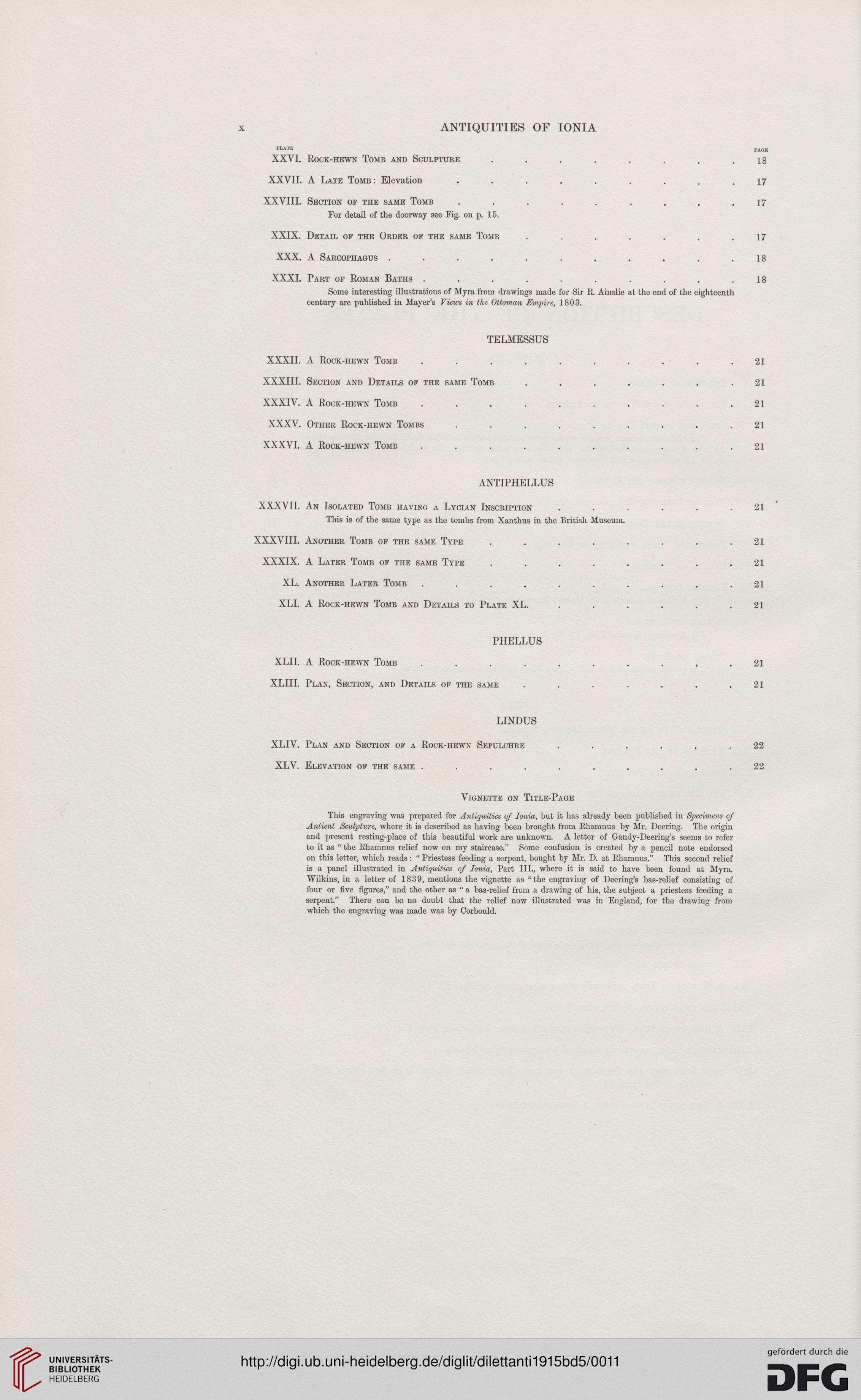ANTIQUITIES OF IONIA
XXVI. Rock-hewn Tomb and Sculpture ........
XXVII. A Late Tomb: Elevation .........
XXVIII. Section op the same Tomb .........
For detail of the doorway see Fig. on p. 15.
XXIX. Detail of the Order of the same Tomb .......
XXX. A Sarcophagus ...........
XXXI. Part of Roman Baths ..........
Some interesting illustrations of Myra from drawings made for Sir E. Ainslie at the end of the eighteenth
century are published in Mayer's Views in the Ottoman Umpire, 1803.
PAGE
18
17
17
17
18
18
TELMESSUS
XXXII. A Rock-hewn Tomb
XXXIII. Section and Details of the same Tomb
XXXIV. A Rock-hewn Tomb
XXXV. Other Rock-hewn Tombs
XXXVI. A Rock-hewn Tomb
21
21
21
21
21
ANTIPHELLUS
XXXVII. An Isolated Tomb having a Lycian Inscription
This is of the same type as the tombs from Xanthus in the British Museum.
XXXVIII. Another Tomb of the same Type ....
XXXIX. A Later Tomb of the same Type ....
XL. Another Later Tomb ......
XLI. A Rock-hewn Tomb and Details to Plate XL.
21
21
21
21
21
PHELLUS
XLII. A Rock-hewn Tomb ....
XLIII. Plan, Section, and Details of the same
21
21
LINDUS
XLIV. Plan and Section of a Rock-hewn Sepulchre
XLV. Elevation of the same ....
22
22
Vignette on Title-Page
This engraving was prepared for Antiquities of Ionia, but it has already been published in Specimens of
Antient Sculpture, where it is described as having been brought from Ehamnus by Mr. Deering. The origin
and present resting-place of this beautiful work are unknown. A letter of Gandy-Deering's seems to refer
to it as " the Ehamnus relief now on my staircase." Some confusion is created by a pencil note endorsed
on this letter, which reads: " Priestess feeding a serpent, bought by Mr. D. at Ehamnus." This second relief
is a panel illustrated in Antiquities of Ionia, Part III., where it is said to have been found at Myra.
Wilkins, in a letter of 1839, mentions the vignette as "the engraving of Deering's bas-relief consisting of
four or five figures," and the other as " a bas-relief from a drawing of his, the subject a priestess feeding a
serpent." There can be no doubt that the relief now illustrated was in England, for the drawing from
which the engraving was made was by Corbould.
XXVI. Rock-hewn Tomb and Sculpture ........
XXVII. A Late Tomb: Elevation .........
XXVIII. Section op the same Tomb .........
For detail of the doorway see Fig. on p. 15.
XXIX. Detail of the Order of the same Tomb .......
XXX. A Sarcophagus ...........
XXXI. Part of Roman Baths ..........
Some interesting illustrations of Myra from drawings made for Sir E. Ainslie at the end of the eighteenth
century are published in Mayer's Views in the Ottoman Umpire, 1803.
PAGE
18
17
17
17
18
18
TELMESSUS
XXXII. A Rock-hewn Tomb
XXXIII. Section and Details of the same Tomb
XXXIV. A Rock-hewn Tomb
XXXV. Other Rock-hewn Tombs
XXXVI. A Rock-hewn Tomb
21
21
21
21
21
ANTIPHELLUS
XXXVII. An Isolated Tomb having a Lycian Inscription
This is of the same type as the tombs from Xanthus in the British Museum.
XXXVIII. Another Tomb of the same Type ....
XXXIX. A Later Tomb of the same Type ....
XL. Another Later Tomb ......
XLI. A Rock-hewn Tomb and Details to Plate XL.
21
21
21
21
21
PHELLUS
XLII. A Rock-hewn Tomb ....
XLIII. Plan, Section, and Details of the same
21
21
LINDUS
XLIV. Plan and Section of a Rock-hewn Sepulchre
XLV. Elevation of the same ....
22
22
Vignette on Title-Page
This engraving was prepared for Antiquities of Ionia, but it has already been published in Specimens of
Antient Sculpture, where it is described as having been brought from Ehamnus by Mr. Deering. The origin
and present resting-place of this beautiful work are unknown. A letter of Gandy-Deering's seems to refer
to it as " the Ehamnus relief now on my staircase." Some confusion is created by a pencil note endorsed
on this letter, which reads: " Priestess feeding a serpent, bought by Mr. D. at Ehamnus." This second relief
is a panel illustrated in Antiquities of Ionia, Part III., where it is said to have been found at Myra.
Wilkins, in a letter of 1839, mentions the vignette as "the engraving of Deering's bas-relief consisting of
four or five figures," and the other as " a bas-relief from a drawing of his, the subject a priestess feeding a
serpent." There can be no doubt that the relief now illustrated was in England, for the drawing from
which the engraving was made was by Corbould.




